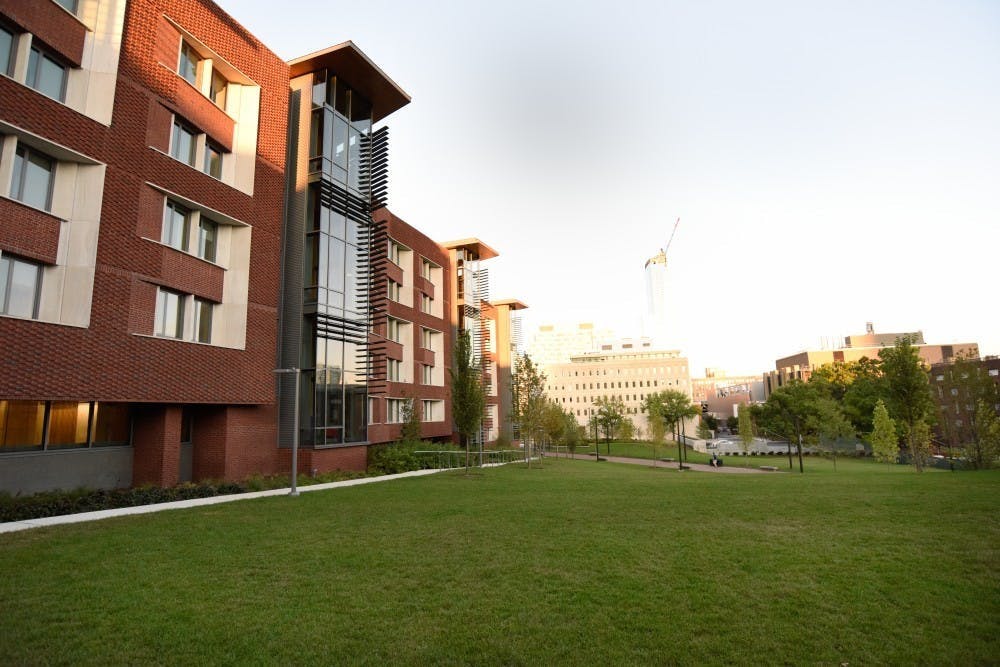Remember those mysterious people standing next to the garbage and recycling bins at New Student Orientation (NSO) who were eager to take your empty pudding containers? Or the people handing out those flashy thermos water bottles? Those were students from Penn Sustainability, a club whose mission tackles so much more than just handing out merchandise or collecting garbage.
Penn Sustainability is a university initiative committed to both furthering environmental sustainability at Penn and fostering programs to build a more sustainable campus. The Penn Sustainability team in charge of these efforts is comprised of three full–time staff members, four student interns, 140 faculty and staff eco–representatives, and 23 student eco–representatives. The Penn Sustainability team lives within the Office of the University Architect, Mark Kocent, who works closely with various members of the organization.
Within Penn Sustainability’s larger mission of building a more sustainable campus, the team has split the work into seven individual subcommittees: Academics, Utilities & Operations, Physical Environment, Waste & Recycling, Purchasing, Transportation, and Outreach & Engagement. Work on each of the seven subcommittees are coordinated through the Environmental Sustainability Advisory Committee (ESAC).
“Overall when we first established the ESAC committee about a decade ago, when we started the first Climate Action Plan, it was under the direction of Dr. Gutmann who had signed the Presidents’ Climate Commitment to achieve carbon neutrality for the entire campus by 2042,” Kocent says.
Since Gutmann signed the Commitment in 2007, Penn Sustainability has authored a Climate Action Plan every five years. The document serves as a roadmap, setting goals for each of the seven individual initiatives all with the larger goal of reaching carbon neutrality by 2042 in mind.
Climate Action Plan 3.0, released earlier this year, features a number of goals, including using the campus as a laboratory for research in the sustainability field, increasing the waste diversion through landfills and educating the Penn community on what waste can be recycled and composted. One goal specific to the next five years is the acquisition of a Power Purchase Agreement.
“Essentially the PPA is a large purchase of solar power that will help offset the emissions from our electricity used on campus,” Kocent says. “It would probably be a 20 to 25 year commitment that would involve likely offsetting about 70% of our emissions from electricity.”
While the PPA is not yet confirmed, and work on its production has not yet begun, Kocent says it will likely take “a few months to resolve all the details” before the agreement is signed sometime in the spring.
In addition to the Climate Action Plans produced every five years, Penn Sustainability publishes annual reports tracking the progress of the five year goals.
“The five year plan sets the roadmap and then the annual reports say ‘Where are we at? What have we done? What do we still have left to do?’” Sustainability Analyst Madeline Schuh says.
Within Penn Sustainability, there are a number of ways in which students can get involved, namely through the Student Advisory Group for the Environment.
“When we were in the planning process we wanted to get student input and feedback on the plan that had been developed, but it was often difficult for students to get involved with each of the subcommittees,” Schuh says. “We created SAGE, which is for students only, as a way to get student feedback, ask questions and to have students be a part of the process.”
Student involvement is a key aspect to Penn Sustainability. Penn Sustainability intern Abbey Waugh (C ‘20) encourages all students to get involved in one way or another.
“I feel that, largely, most people do not know what Penn is doing to be sustainable and they just make assumptions that Penn is doing nothing,” Abbey says. “So before you make any assumptions, I would tell students to read the [Climate Action] Plan. Maybe after reading you will make the same judgement, but just read it first. And then go out and try to teach others about it.”

